- Author Matthew Elmers [email protected].
- Public 2023-12-16 21:49.
- Last modified 2025-01-24 09:17.
The first samples of electroshock weapons (stun guns, stun devices - ESHU) under the name "electric whip" appeared at the beginning of the 20th century and were intended to control livestock. Later, stun guns were developed for use by law enforcement, who were initially skeptical of them, but gradually stun guns became an integral part of police equipment in many countries. The next stage in the development of stun guns took place in 1974, when former NASA researcher Jack Cover developed and patented the TASER TF-1 stun gun (patent called "Immobilization and Detention Weapon") capable of striking a target at a distance.
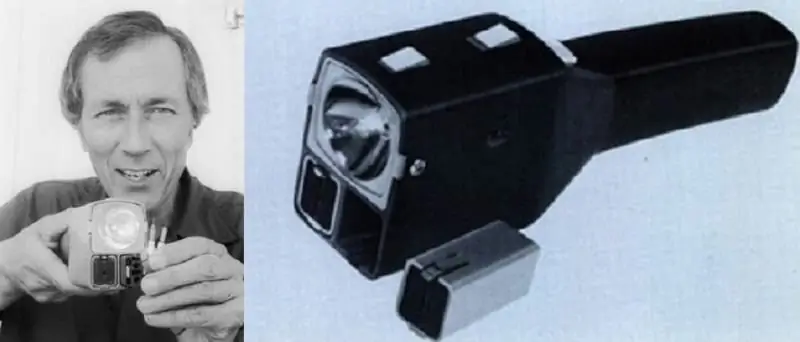
At the moment, TASER International can be considered the world leader in the production of remote electric shock devices (DESHU). The main manufactured models are the TASER X2 and TASER X26P dual-charge DESHUs. The compact single-shot TASER Pulse + is also available.
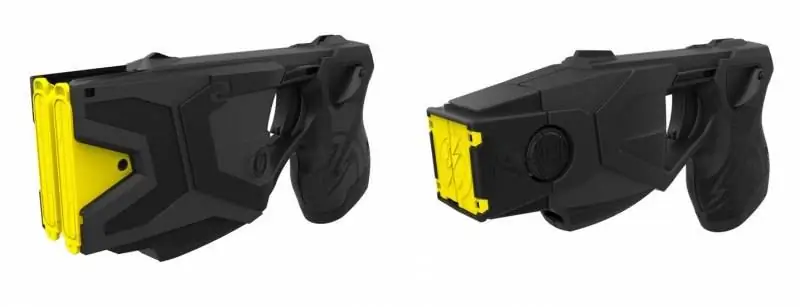

Despite the declared non-lethality of TASER International's DES, there have been hundreds of fatal cases when they were used by the US police.
Civil ESHU in Russia
In Russia, the first samples of stun guns began to be produced in 1992 by the company "MART" for the needs of the Ministry of Internal Affairs. In civilian circulation, stun guns were in the "gray zone" for some time, until in July 1997 amendments were made to the updated "Law on Weapons", with the active assistance of the same company "Mart". Most likely, it was the commercial interest that led to the fact that only domestically produced stun guns are allowed on the Russian market, the traumatic weapon market came to the introduction of protectionist measures much later.
In this regard, one cannot fail to mention the Chinese pseudo stun guns in the form of telephones, lanterns, powder boxes and other household items that have bred in huge numbers. Despite the beautiful spark discharge they provide, the real efficiency of Chinese pseudo-ESHU tends to zero, at best you can try to scare off a not very aggressive animal. Most likely, it is the low efficiency, which does not allow formally classifying the Chinese ESDs as weapons, that is the reason for the lack of interest in the authorities in the free circulation of such uncertified devices.
According to GOST R 50940-96, three classes of stun guns are installed in Russia:
- 1st class - devices with a voltage of 70-90 kilovolts (power 2-3 W). The maximum achievable effect is temporary paralysis, loss of consciousness.
- 2nd class - devices with a voltage of 45-70 kilovolts (power 1-2 W). Perceptible pain effect, manifested within 2-10 seconds after the termination of exposure, loss of orientation and coordination.
- 3rd class - devices with voltage less than 20-45 kilovolts (power 0.3-1 W). They have minimal effectiveness, providing a slight numbness of the extremities, inhibition of the reaction. Can be used to scare away animals.
One of the main criteria ensuring the effective incapacitation of an aggressive enemy is the power of the stun gun. The lower the power, the longer it is necessary to keep the ESD electrodes on the target. The power of more than 25 watts realized in the American TASER stun guns allows you to "turn off" the target with almost one touch.
In Russia, due to the power limitation of 3 W for the civilian market and 10 W for the special equipment market, the effectiveness of stun guns as a weapon of self-defense tends to zero. In fact, they could only be regarded as a kind of instrument of torture (stun guns are banned in some countries of the world precisely because of the possibility of their use in this capacity).
Despite the restrictions imposed by Russian legislation on the characteristics of stun guns, it must be understood that in many countries of the world they are generally inaccessible to the population, like many other types of self-defense weapons. Stun guns are completely and partially banned for the civilian population in Australia, Germany, Hong Kong (up to 14 years in prison), Sweden, Great Britain. Even in the United States, the purchase and use of stun guns is not permitted in all states.
At the same time, research in the technology of electric shock to a person has made it possible to significantly reduce the required power of stun guns without losing efficiency. In 2003, Taser International filed a patent application in the USA for a new Shaped-Pulse Technology. With this scheme of work, the duration of individual pulses is significantly increased, and the longer the pulse duration, the greater the efficiency of electrical stimulation of muscle contraction. This made it possible to create a 7 W ESD TASER X26 with an efficiency 5% higher than that of the TASER M26 with a 26 W power. Thus, the frequency, duration and shape of the electric pulse in the ESH are no less, and possibly more, than just the electrical power supplied to the combat electrodes.
Currently, Russian manufacturers also use technologies similar to Shaped-Pulse Technology, in particular, Oberon-Alpha CJSC uses a high-voltage pulse formation technology called neuromuscular blockade. In the product line of domestic manufacturers, there are relatively large models in the shape of a baton and more compact models for carrying in a pocket or in a case.
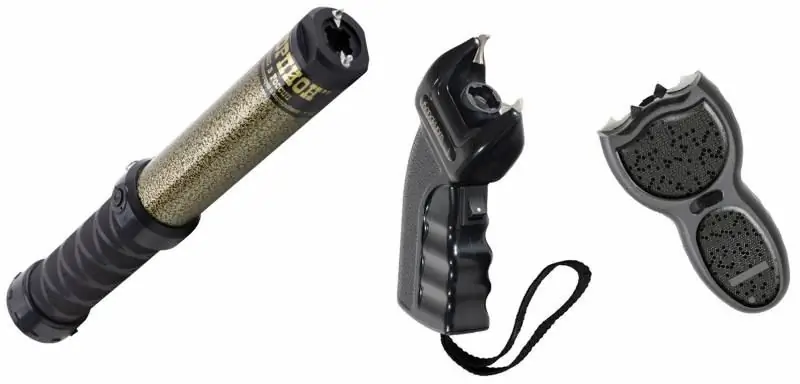
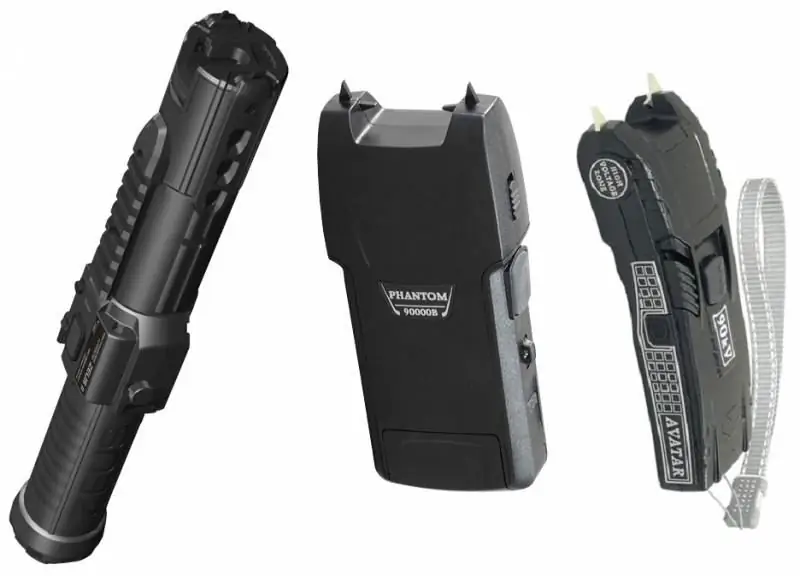
Both Russian manufacturers - "MART GROUP" and "Oberon-Alfa" have released their versions of stun guns with a remote effect on the enemy, provided through the use of special cartridges. The MART GROUP cartridge is called the Electric Discharge Transportation Unit (BTER), the Oberon-Alpha cartridge is called the Remote Cartridge (CD).


Remote strike cartridges can be used in conjunction with some ESDs from the line produced by the respective manufacturer. Also, both Russian manufacturers have released pistol-shaped DESHUs, primarily intended for remote target destruction. For "MART GROUP" it is the AIR "M-140" stun gun, capable of defeating one remote target.
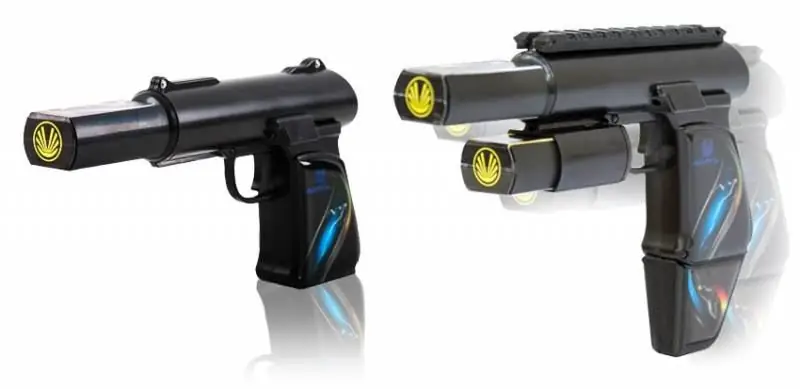
The company "Oberon-Alpha" has released a double-charged DESHU "Hybrid", which includes two power modules, which provides the possibility of simultaneous remote hitting of two targets and contact hitting a third target with four combat electrodes. At the moment, the DESHU "Hybrid" is available only to representatives of law enforcement agencies, in connection with which there are no reviews of its real operational efficiency, however, according to some reports, certification of the DSHU "Hybrid" for the civilian market is still planned.

It should be noted that ESHU of Russian manufacturers are very expensive. On the one hand, the market is closed from foreign competitors, on the other hand, the cost of high-quality foreign DES like TASER X2 and TASER X26P exceeds $ 1000-1300, so their appearance on the Russian market would hardly force domestic manufacturers to change their pricing policy. Much worse is the fact that cartridges for remote shooting have a fairly high cost. On the one hand, a stun gun is not pneumatics designed for recreational shooting, on the other hand, it is possible to speak about the possibility of effective use of any weapon only based on the results of regular training. In this sense, manufacturers should consider the possibility of both reducing the cost of "combat" cartridges and releasing their training counterparts with a simplified design (for example, fishing line instead of wires, etc.). It may also make sense to consider returning used cartridges at a discount when buying new ones.
Promising Russian ESHU
Speaking about domestic electroshock devices, one can not fail to note one interesting development. At the Interpolator-2013 exhibition, Electroshock Technologies LLC demonstrated a five-charge remote stun gun PDG-S5. Its distinctive feature was the automatic supply of cartridges (cartridges for transporting the KTP-1 discharge), with an electrode and a wire placed in them, from the pistol holder. Thus, ten rounds allow five shots to be fired (cartridges are fired in pairs). At the moment, DESHU PDG-S5 is the most recharging device of all stun guns produced in the world. In 2009, TASER International announced the TASER X3 three-shot model, but it was not possible to find it on the manufacturer's website, apparently this DESHU was discontinued. The downside of PDG-S5 can be considered the impossibility of simultaneous defeat of several opponents, as can be done by the DESHU "Hybrid" and its analogs, since after the next shot the contact with the ejected cartridges will be lost. For some time, the PDG-S5 DESHU could be purchased for civilian use, but there is no information on its certification. At the moment, Electroshock Technologies LLC is bankrupt, DESHU PDG-S5 is rarely found on the secondary market at completely inhumane prices, however, in the absence of the possibility of purchasing cartridges, the meaning of its purchase is unclear.
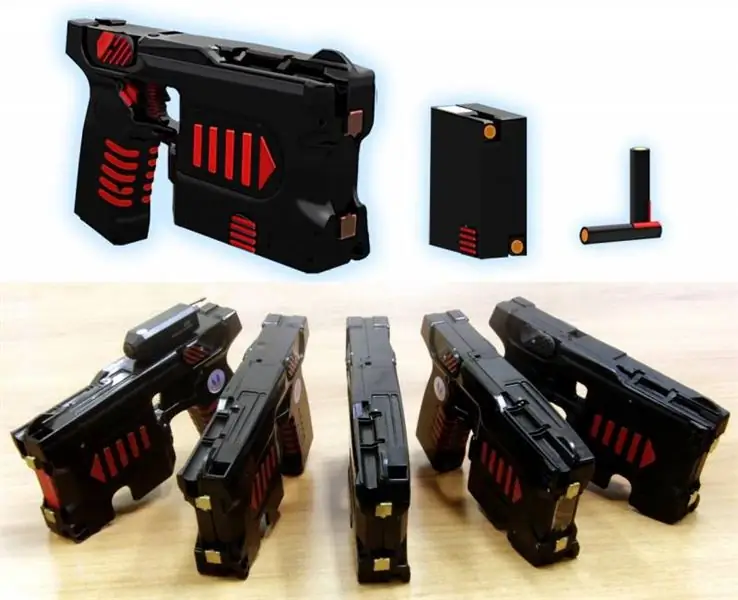
The concept of a rechargeable remote stun gun has not died and is being actively developed by JSC "RTEX-NO" under the brand "GARD". Even in appearance, one can understand that DESHU "GARD" is the direct successor of DESHU PDG-S5. The product is intended for law enforcement agencies, it has not been announced for the civilian market, however, given that business always requires an expansion of the sales market, and the license of JSC RTEX-NO applies not only to service, but also to civilian products, such a possibility cannot be ruled out. At the beginning of 2019, before the meeting of the board of the Ministry of Internal Affairs, the DESHU "GARD" was demonstrated to the President of the Russian Federation Vladimir Putin, it is reported that it will soon be adopted by the Ministry of Internal Affairs.
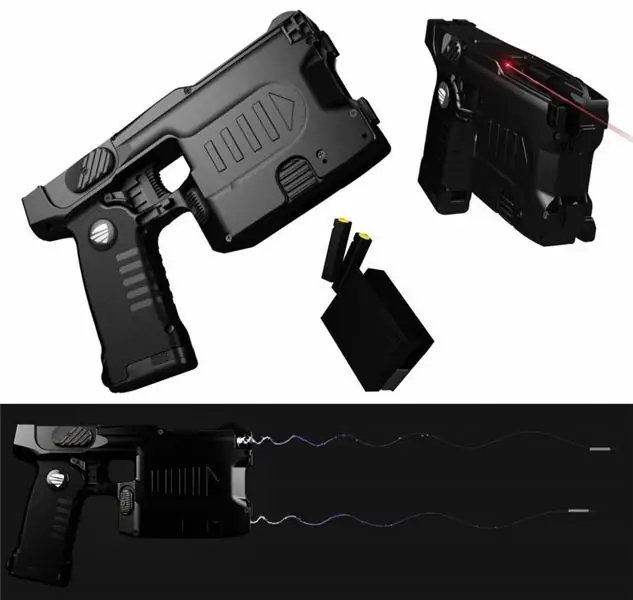

Prospects for the development of ESHU / DESHU
Unlike traditional firearms, which largely exhausted the direction of development back in the 20th century, weapons with an electric method of destruction are only at the initial stage of their development. Of course, it will not replace firearms, but it can effectively complement them.
How can ESHU / DESHU develop? First of all, the growth of the battery capacity will reduce the dimensions of the ESD, increase the "ammunition" while maintaining power, or increase the number of simultaneously hit targets (for the DES). A huge number of high-current batteries of large enough capacity have entered the market thanks to the vaping industry. It can be expected that the rapidly growing market for electric vehicles, as well as small electric unmanned aerial vehicles (UAVs) - quadrocopters and the like, will become a significant incentive for further improvement of batteries.
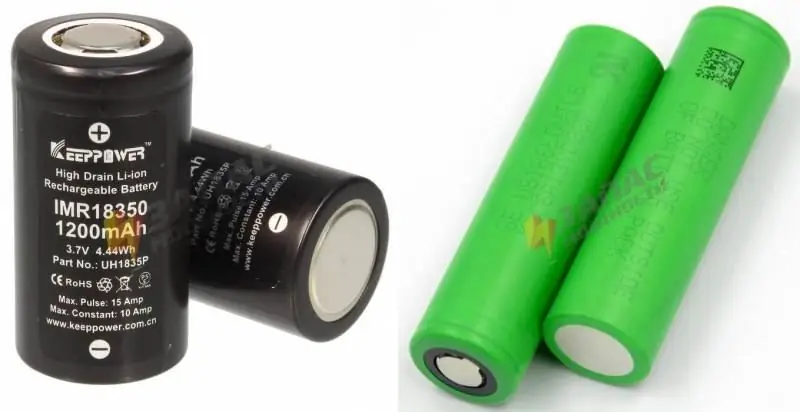
The electrical nature of ESHU implies the possibility of widespread use of auxiliary devices - built-in laser designators (LTS), flashlights, video recorders, sound signaling devices and similar components that can turn ESHU / DESHU into a kind of "combine".
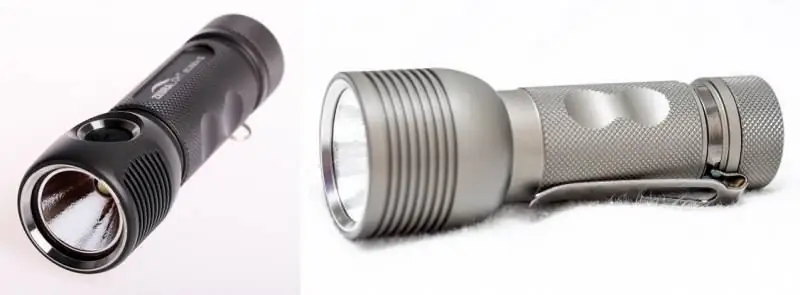
It is obvious that multi-charge cartridges for DESU will receive further development. The normal ammunition capacity will be about 3-5 shots, and for large-sized police models it is possible that up to 10 shots. The ejection of contact electrodes (harpoons) in the cartridges can be carried out with compressed gas, while placing the gas cylinder separately from the cartridge can be considered in order to reduce the cost of the latter. A more effective solution can be considered the release of harpoons using a compact powder charge, initiated from an electric igniter capsule (EKV), similar to those used in cartridges for traumatic pistols "Wasp".
In addition to cartridges for remote electrocution of the enemy, light and sound cartridges, cartridges with irritating substances (tear gas), similar to those used in cartridges for aerosol pistols such as "Udar", "Premier", marking cartridges (paint), can be used.

Much of the proposed has already been implemented or is planned for implementation, in one form or another, in ESHU / DESHU of domestic and foreign production.
From time to time, there is information about the DES using fundamentally new principles of transmission of an electric discharge - liquid, powder (metal powders or graphite), channels ionized by an ultraviolet laser or microwave radiation. At the moment, all of these developments are at an early stage, have huge dimensions and do not provide any acceptable reliability of discharge transmission, so it is premature to talk about them.
ESHU / DESHU application
How effective are ESHU / DESHU for use by citizens as a weapon of self-defense? First of all, it is necessary to take into account the fact that the use of a stun gun does not guarantee the destruction of the enemy. In principle, this is true for both gas-aerosol and traumatic weapons. But their advantage over ESHU is that there is no need to come into direct contact with the enemy. If we are talking about DESHU, then, as mentioned earlier, the high cost of cartridges does not allow you to train and feel confident with a weapon, this is especially true for single-shot DESHUs, which are still the majority. In general, now ESHU and DESHU are suitable for self-defense against one enemy, and preferably not armed.
What can turn the tide? The emergence of relatively compact multi-charge (3-5 shots) DESHU with cartridges, with an acceptable cost of 100-200 rubles per shot.
How ESHU / DESHU can be used now? Primarily as a second weapon along with an aerosol pistol or a gas canister. In a situation where the enemy is disoriented beforehand, an electric shock will help "consolidate" the effect. This is preferable to the use of physical force, which can inadvertently lead to injury or death of the enemy, with the subsequent release of the defender. It is hardly worth recommending ESHU / DESHU for use in self-defense by insecure people, since, as already mentioned, ESHU requires direct contact with the enemy, and the presence of one shot at the ESHU suggests a high probability of a miss in a stressful situation. In this case, a gas cartridge can be considered the best choice.
In general, it can be assumed that the improvement of stun guns in terms of increasing the number and reducing the cost of shots for remote destruction of the enemy can make the DESHU comparable in effectiveness to weapons of limited destruction (traumatic), but more accessible to citizens due to the lack of the need to obtain a license.






